Article takeaways
- The most popular storage unit sizes in New York are 5×10 (29% of rentals), 5×5 (28% of rentals), and 10×10 (18% of rentals).
- New Yorkers primarily use storage to overcome space limitations in small apartments, store business inventories, and keep seasonal items organized.
- New York storage unit prices tend to be higher than the national average.
- New Yorkers can save money by renting during off-peak months (December to February), sharing larger units with friends for a lower per-square-foot price, and maximizing space via vertical stacking and disassembling furniture.
Despite the media’s hip fantasies, the reality of living in a small and tall urban setting like the city that never sleeps is expensive, with small living spaces, old buildings, and harsh seasons.
My mom’s side of the family is from NYC. I love it there, but I’m not the only one. The influx of people into a city that’s already suffering from space limitations has driven up the storage demand.
And for good reasons – New Yorkers have figured out that the best way to free up some living space clutter is to supplement their small apartment or outdoor space by renting a storage unit.
But not all storage units are created equal. If you fail to book the right type of unit for their storage needs, New York’s seasonal climate can destroy some of your personal items, depending on what you’re storing.
Storage units are priced based on the square footage. Pick too small a unit size, and you risk running out of space to organize and maintain your stuff efficiently. If you go for too large a unit, then you’re paying for space you’re not using.
That’s why SelfStorage.com put together this New York storage space guide covering the types of units New Yorkers are renting, and we’ve got the receipts to prove it. This New York storage unit size guide lists the most popular unit sizes in the state. We’ll tell you what to expect when you rent each storage unit size.
We’ll also reveal how SelfStorage.com can help you find the exact size unit you need, with the precise features you’re looking for, in a convenient location of your choosing.
The Benefits of Self-Storage: How Renting a Storage Unit Can Help New Yorkers
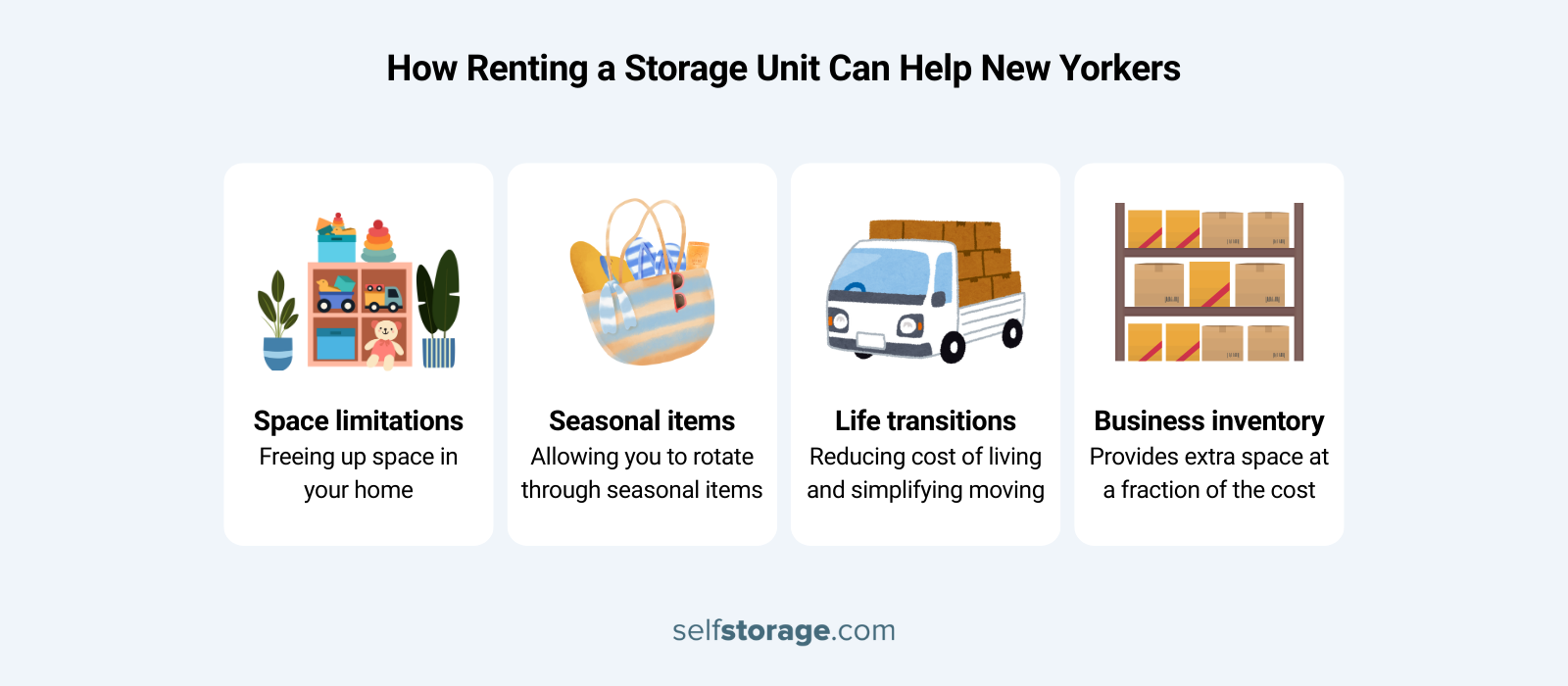
Renting a self-storage unit can help New Yorkers in a variety of ways. The benefits of self-storage for New Yorkers include: alleviating space limitations, providing seasonal storage, aiding you during life transitions, or serving as a small business inventory warehouse or e-commerce storage space.
Space Limitations
Off-site storage lets you keep stuff that is sentimental or valuable, but that you might not use every day. Putting these possessions in a storage unit frees up space in your home without having to get rid of anything.
Storage for Seasonal Items
- A storage unit is also the ideal place for seasonal storage, allowing you to rotate through seasonal items like holiday decorations, sports and bicycle gear, winter jackets and boots, and the hiking gear you use upstate.
- When winter rolls around, swap your bicycle and riding gear for your snow boots and winter layers, and you only need to keep one or the other at home at a time without giving up any of your hobbies.
Storage During Life Transitions
One of the downsides of moving to the city is what furniture to keep and what furniture to get rid of once they lose a room or two worth of space. A storage unit allows New Yorkers to create a furniture rotation schedule so they can still use all their furniture.
And if down the road you start shedding hobbies or decide rotating furniture is too much of a hassle, you can always reorganize and downsize your storage unit.
Speaking of downsizing, the rising cost of living both in New York and around the country makes downsizing our living space to reduce our cost of living more appealing than ever.
The benefits of downsizing your home with storage support include reduced emotional and mental stress, extra living space, and lower monthly expenses, even with the added cost of storage.
New Yorkers also take advantage of storage unit rentals when they need additional space or a place to store things while moving out of apartments or between boroughs. A self-storage unit lets you pack a little every day, starting weeks in advance.
And whether you’re moving yourself or hiring a professional moving service, having all your belongings packed, organized, and staged in your storage unit on moving day saves time and money.
Finally, whether you’re moving to New York for college or are from the city and leaving home to live on campus, a storage unit makes a great backup closet for students.
Store your seasonal items, bulky furniture, and anything you don’t use daily in a storage facility located near your campus to keep your dorm room or college apartment from feeling cramped.
That way, you don’t need to fill your dorm room with stuff. But you also don’t have to go back to your parents’ house every time you need something.
And instead of hauling everything home during summer and winter breaks, just keep it close to campus in your unit, ready to move back into the dorms next semester.
Business Inventory and Commerce Storage Needs
New Yorkers can also use a storage unit as a spacious, secure extension of their cramped office or studio space. A storage unit provides extra space at a fraction of the cost and commitment of renting a warehouse, office, or studio space in New York City. The following table explains the benefits that self-employed New Yorkers, artists, musicians, writers, and all types of small business owners in New York can reap by using self-storage as a business inventory and office/workshop solution:
| Benefits | How It Helps New Yorkers |
|---|---|
| More Space for Organization: | Keeps New Yorkers’ inventories neat and easy to find. |
| Enhanced Security Features: | Advanced security measures protect business assets, backstock, office/art supplies, and the final product. |
| Financial Savings: | More affordable than larger commercial spaces in New York City. |
| Standard Maintenance: | Climate-controlled environments maintain product integrity, and extra space allows New York businesses to maintain shipping schedules, inventory and supply maintenance, and organization techniques like First In, First Out, etc. |
| Frees Business Owners From Distractions: | Allows extra time, space, and mental and physical energy for creativity and managing other aspects of the process. |
Now that we know why New Yorkers are taking advantage of storage unit benefits, let’s take a look at the most common size choices.
Storage Facility Data: The 3 Most Popular Storage Unit Sizes in New York
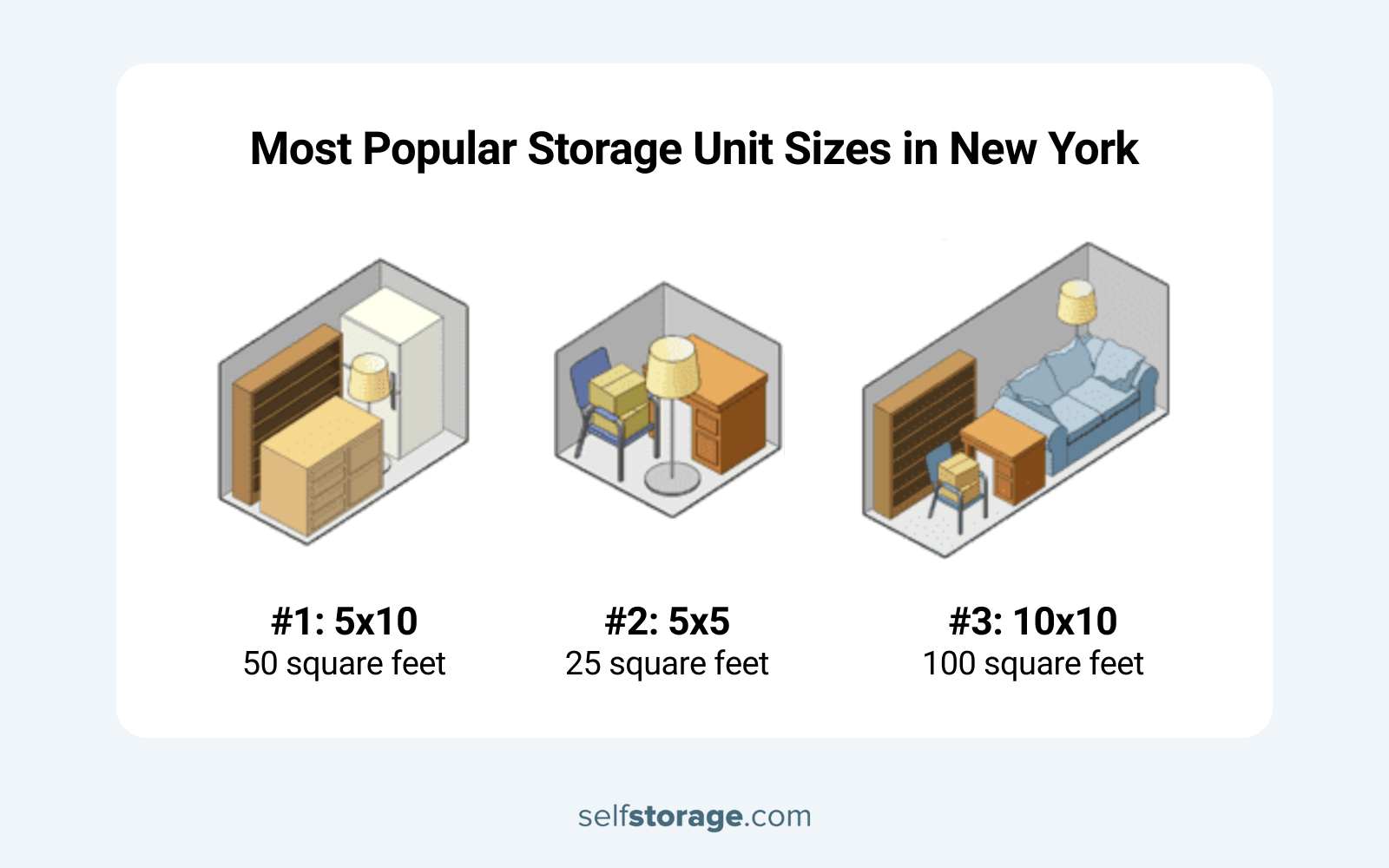
It’s no surprise that the three most popular storage unit sizes in New York are the “big three” unit sizes, the 5×10, 5×5, and 10×10.
Here at SelfStorage.com, we connect users to more than 20,000 storage facilities nationwide. We track the reservation rates by city, state, and unit size to find out exactly which sizes are the most popular in each region. We use this information to help our readers decide what unit size they might need by analyzing the choices other people in their areas are making.
We sampled 25,621 storage units that were rented through our self storage marketplace in 2025. Here are our findings on the most popular storage unit sizes in NY for each month of the year:
| Month/Year | Storage Unit Size | Percentage of Units Rented |
|---|---|---|
| February 2025 | Oversize | 0.10% |
| January 2025 | 10×25 | 0.15% |
| January 2025 | Oversize | 0.16% |
| March 2025 | Oversize | 0.17% |
| June 2025 | Oversize | 0.18% |
| March 2025 | 10×25 | 0.18% |
| August 2025 | Oversize | 0.19% |
| February 2025 | 10×25 | 0.19% |
| February 2025 | 10×30 | 0.19% |
| March 2025 | 10×30 | 0.20% |
| May 2025 | 10×25 | 0.21% |
| April 2025 | 10×25 | 0.22% |
| June 2025 | 10×25 | 0.24% |
| July 2025 | Oversize | 0.26% |
| April 2025 | Oversize | 0.26% |
| May 2025 | Oversize | 0.28% |
| April 2025 | 10×30 | 0.30% |
| August 2025 | 10×25 | 0.31% |
| January 2025 | 10×30 | 0.31% |
| July 2025 | 10×25 | 0.33% |
| August 2025 | 10×30 | 0.34% |
| May 2025 | 10×30 | 0.37% |
| July 2025 | 10×30 | 0.44% |
| June 2025 | 10×30 | 0.44% |
| February 2025 | 5×15 | 0.64% |
| March 2025 | 5×15 | 0.70% |
| January 2025 | 5×15 | 0.76% |
| April 2025 | 5×15 | 0.90% |
| February 2025 | 10×20 | 0.91% |
| August 2025 | 5×15 | 0.93% |
| May 2025 | 5×15 | 0.99% |
| February 2025 | 10×15 | 1.05% |
| June 2025 | 5×15 | 1.09% |
| July 2025 | 5×15 | 1.19% |
| January 2025 | 10×20 | 1.21% |
| March 2025 | 10×15 | 1.22% |
| June 2025 | 10×20 | 1.23% |
| January 2025 | 10×15 | 1.24% |
| April 2025 | 10×20 | 1.26% |
| June 2025 | 10×15 | 1.34% |
| March 2025 | 10×20 | 1.36% |
| April 2025 | 10×15 | 1.36% |
| July 2025 | 10×20 | 1.40% |
| May 2025 | 10×20 | 1.40% |
| August 2025 | 10×20 | 1.42% |
| May 2025 | 5×5 | 6.79% |
| May 2025 | 5×10 | 6.67% |
| June 2025 | 5×10 | 5.77% |
| August 2025 | 5×10 | 5.55% |
| July 2025 | 5×10 | 5.33% |
| April 2025 | 5×10 | 5.27% |
| April 2025 | 5×5 | 5.23% |
| July 2025 | 5×5 | 4.95% |
| February 2025 | 5×5 | 4.94% |
| June 2025 | 5×5 | 4.77% |
| August 2025 | 5×5 | 4.72% |
| March 2025 | 5×10 | 4.61% |
| March 2025 | 5×5 | 4.41% |
| January 2025 | 5×10 | 4.13% |
| January 2025 | 5×5 | 3.94% |
| May 2025 | 10×10 | 3.74% |
| February 2025 | 5×10 | 3.65% |
| July 2025 | 10×10 | 3.44% |
| April 2025 | 10×10 | 3.34% |
| August 2025 | 10×10 | 3.30% |
| June 2025 | 10×10 | 3.09% |
| March 2025 | 10×10 | 2.88% |
| January 2025 | 10×10 | 2.79% |
| February 2025 | 10×10 | 2.69% |
| July 2025 | 10×15 | 1.64% |
| August 2025 | 10×15 | 1.54% |
Now that you can clearly see that the 5×10, 5×5, and 10×10 unit sizes are the most popular, let’s break down each of the three most common storage unit sizes to help decide which is the ideal choice for your specific storage needs.
First Most Popular Storage Unit Size: 5×10 Self-Storage Units
5×10 storage units boast around 50 square feet of floor space. The amount of cubic feet varies by height. For example, if your unit is 8 feet tall, your equation becomes 5x10x8=400 cubic feet.
A 5×10 is large enough to fit all the contents of a small bedroom or a small studio apartment, especially if you break down all the furniture beforehand. This makes them the ideal size for college students and young people who live with roommates or alone in a small apartment.
Our storage facility numbers show that 5×10 storage units make up 7,487 of the 25,621 storage unit rentals we analyzed. That’s just a fraction over 29% of the total rentals, putting 5×10 in first place for the most popular storage unit size in NYC.
Price-wise, the popularity of 5×10 units boosts the New York price average above the national average. The average monthly unit price of a 5×10 in New York is $92.09, almost double the national average of $50.20.
If you break that down into square feet, you’re looking at about $1.84 per square foot of storage for a standard 5×10 unit in New York. That said, adding amenities like climate control may increase that price.
What Can I Fit in a 5×10 Storage Unit?
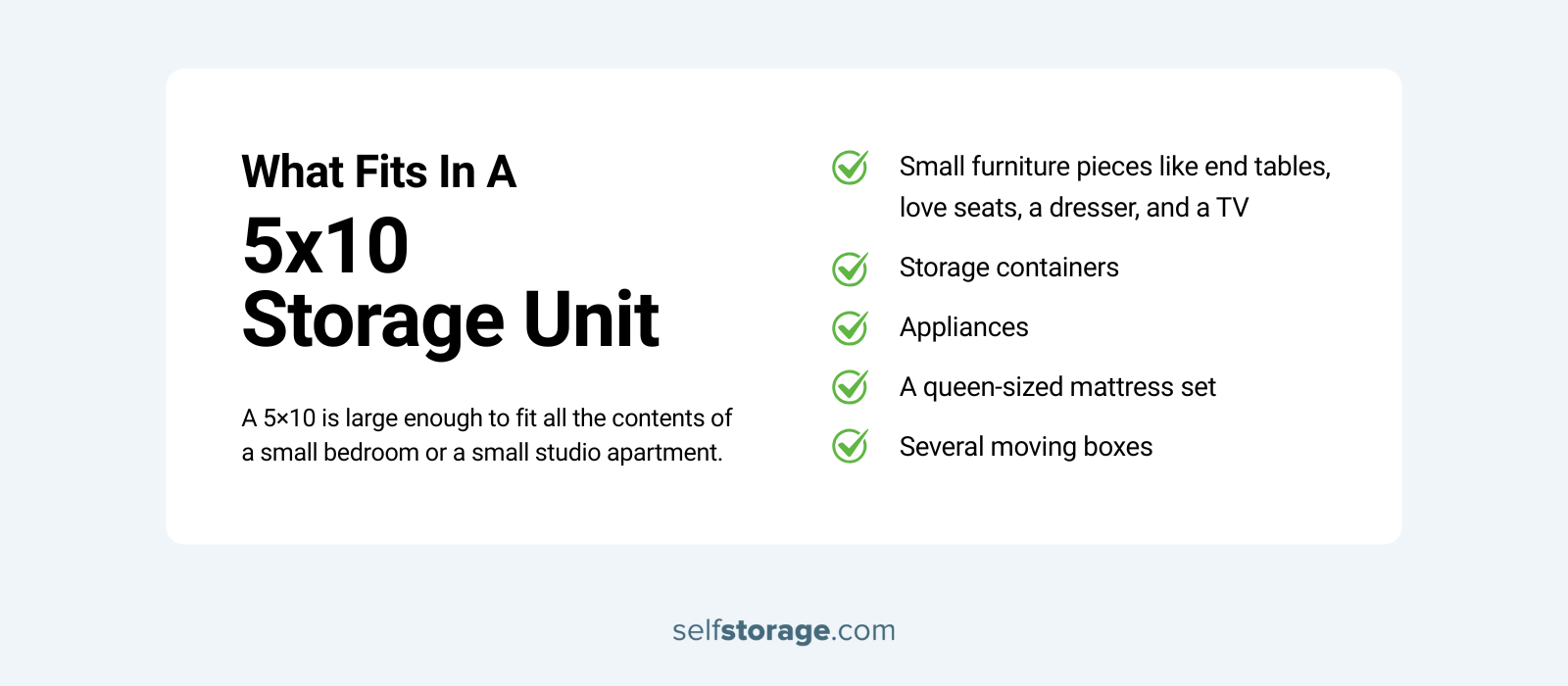
You can fit the contents of 1-2 small rooms into a 5×10 storage unit. These contents include small furniture pieces like end tables and love seats, storage containers, appliances, a queen-sized mattress set, a dresser, a TV, and several moving boxes, especially if you’re stacking boxes.
Common use cases for 5×10 storage units include storing :
- Dorm furniture and college stuff over the summer break
- Seasonal items such as sporting gear, surfboards, snowboards, golf clubs, winter boots, winter jackets, hiking and camping gear, etc.
- Storing stacks of properly packed and organized moving boxes when moving from one apartment to another
Second Most Popular Storage Unit Size: 5×5 Self-Storage Units
A 5×5 storage unit is about the smallest unit size you can rent before entering mini storage territory. Maybe you only need a little extra space to store smaller seasonal items and decorations, a filing cabinet or two full of documents, outdoor equipment, or a few stacks of moving boxes, but you’re on a budget. If that sounds familiar, a 5×5 might be the solution you’re looking for.
With only 25 cubic feet, 5×5 storage units are commonly referred to as storage lockers due to their small size. 5×5 storage lockers are a popular choice for seasonal/short-term storage renters, students, and minimalists whose space requirements and storage needs don’t call for a larger unit. It’s essentially like renting an extra walk-in closet all to yourself.
Of the 25,621 New York storage unit rentals we analyzed, 7,261 were 5x5s. That comes out to just over 28% of all the rentals, putting them in second place by a razor-thin margin.
In terms of prices, the average standard 5×5 costs about $53.62 in New York, making it more expensive than the national average 5×5 price of $33.78.
In cubic feet terms, you’re paying about $2.14 per square foot for a 5×5 in New York. As you can see, the smaller the unit, the more you pay per square foot.
The amount of cubic feet really matters in these smaller storage lockers. With an 8-foot height, you’ve got 200 cubic feet to work with, even though there’s only 25 square feet of floor space. All that to say that you really want to take advantage of the vertical space in these smaller unit sizes.
What Fits in a 5×5 Storage Unit
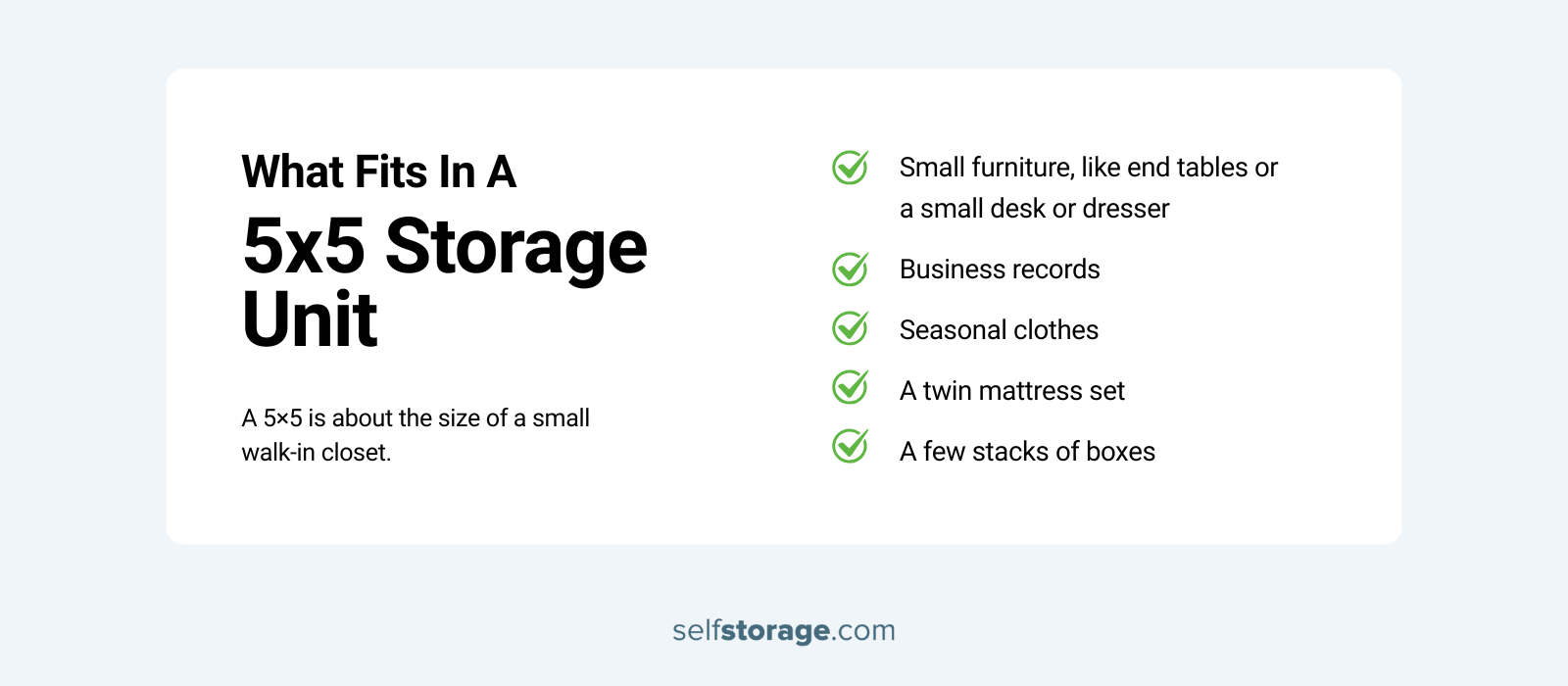
A 5×5 is about the size of a small walk-in closet. A 5×5 storage locker can fit business records, seasonal clothes, small furniture, like end tables or a small desk or dresser, a twin mattress set, or a few stacks of boxes. Here are a few common use cases for 5×5 units:
- New Yorkers who rent a small studio or 1-bedroom apartment and need extra closet space, or a place to keep filing cabinets, a dresser full of seasonal clothing, or clothing/accessories for special occasions.
- Storage for New Yorkers who need to downsize housing due to shrinkflation or lack of availability.
- New Yorkers who lack garage or outdoor storage space for tool boxes, lawn and gardening equipment, or sporting/outdoor gear.
Third Most Popular Storage Unit Sizes: 10×10 Self-Storage Units
A 10×10 storage unit offers 100 square feet of space. This storage size can fit the contents of a two-bedroom house, no problem. A 10×10 is the way to go if you need long-term storage while downsizing to a smaller home, or short-term storage between places or during home renovations.
From couches and kitchen appliances like ovens and fridges to patio and office furniture, kayaks, and bicycle storage, a 10×10 is the third most popular storage unit for a reason: versatility.
10×10 storage units make up 18% of the 25,621 New York storage unit rentals, with 4,615 of the units on the list being 10×10. On a national level, a standard 10×10 storage unit runs around $78.96, but in New York, you’re looking at a typical price of around $133.68.
While this is the most expensive storage size we’ve covered so far in terms of monthly rent, it costs the least amount per square foot, at $1.33 per. This means that it’s more cost-effective to rent one 10×10 storage unit than it is to rent two 5x10s.
So if you think you might need the extra space, we suggest opting for the bigger unit right away rather than adding a second unit down the road.
How Big is a 10×10 Storage Unit?
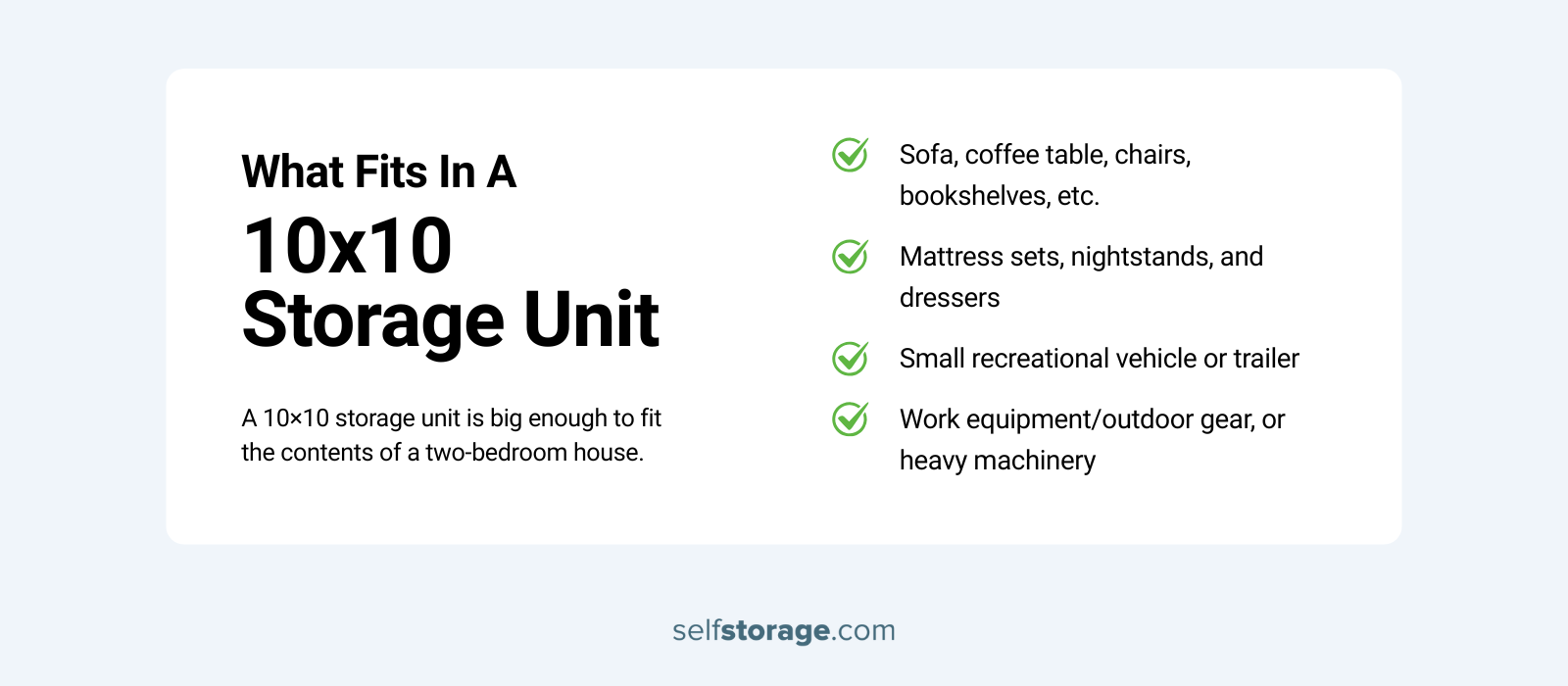
A 10×10 storage unit is big enough to fit the contents of a two-bedroom house, especially if you pack it all efficiently. We’re talking the entire family room, including the sofa, coffee table, chairs, bookshelves, etc., and the contents of two full bedrooms, like mattress sets, nightstands, and dressers.
Here are some storage scenarios where a 10×10 is the ideal choice:
- New Yorkers looking for e-commerce or business storage can use a 10×10 to fit small office furniture, work equipment, and their backstock inventory.
- A 10×10 is a great choice if you need temporary storage for furniture and appliances during home renovations or relocations, or long-term storage when downsizing to a smaller home.
- A 10×10 can fit a small recreational vehicle, such as a jet ski, a snowmobile, an ATV/dirtbike, or a motorcycle.
- Another common use for the 10×10 is storing a small trailer, work equipment/outdoor gear, or heavy machinery.
How to Choose the Right Storage Size for Your NY Storage Needs
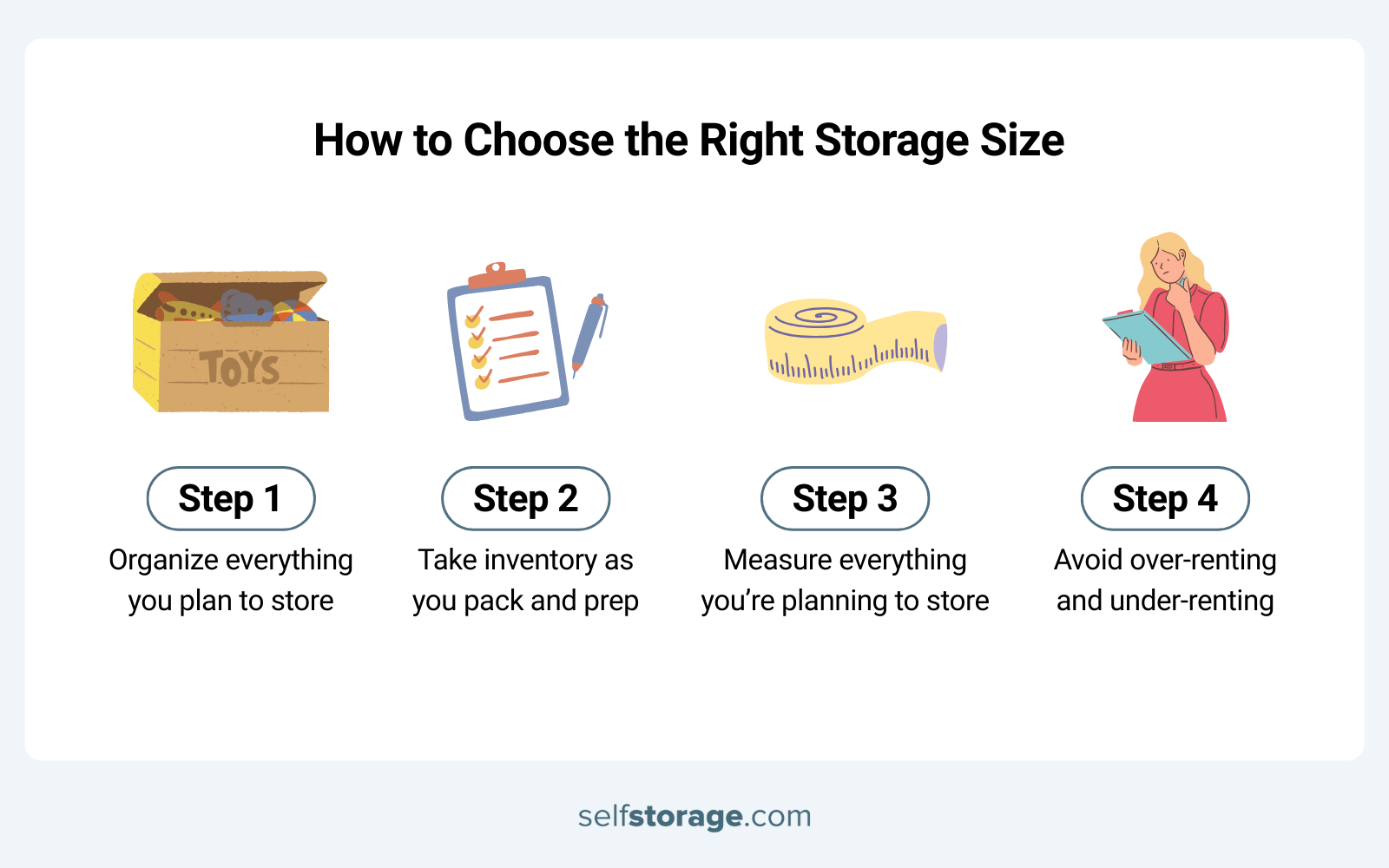
Now that you’re familiar with the most popular storage unit sizes in New York, let’s discuss how to evaluate your storage requirements. We’ll break down the process of determining what storage space you need into four simple steps.
Step 1: Organize Everything You Plan To Store
It may seem counterproductive to prep and pack everything for storage before you even decide on a unit size. But in order to make an honest assessment, you’ll need to see everything in the form it’s going to be while it’s in the unit. That means organizing your things for storage by disassembling furniture pieces, stacking boxes and storage containers, filing all your documents, etc.
Step 2: Take Inventory as You Pack and Prep
We suggest keeping both a written and digital log of everything you plan to store. That means numbering or labeling each box by type and then listing each item you’ll be keeping in each box as you pack them. You may move things around based on trial and error.
But be sure to finalize and update your master storage inventory list once everything is packed up. We suggest keeping the digital version on your phone and putting the physical copy on a clipboard, and leaving it in the unit as a reference to help you find what you need.
Step 3: Measure Everything You Aim To Store
Once your belongings are all broken down and packed up into the state they’ll be stored in, it’s time to get some accurate measurements. Remember, the total square feet is a two-dimensional measurement of the actual floor space. You’ll have to know the length and width of everything you aim to store on the ground level.
But as we said earlier, storage units often have 8-foot high ceilings. Cubic feet is a three-dimensional measurement that multiplies length by width by height. To truly take advantage of your storage space, we suggest measuring the total cubic feet of everything you aim to store and figuring out how you’ll use the vertical space ahead of time.
It may be as simple as stacking boxes. But you’ll need to know how many stacks you can fit and how high they’ll be.
Step 4: Avoid Over-Renting and Under-Renting
The larger the unit size you’re renting, the higher the monthly rent will cost you. So it’s important not to rent more space than you can use.
That said, if you cut it too close, you’re not able to implement organization strategies that let you move around the unit to access all the items in the back without having to take everything up front out of the unit.
Remember, the larger the unit, the less you pay per square foot. That means that it’s cheaper to rent a 5×10 than it is to rent two 5x5s. And it’s cheaper to rent a 10×10 than it is to rent two 5x10s.
You also want to keep future storage needs in mind. Are you planning on accumulating more stuff over the next few months? If so, it’s better to get the extra space you need when you sign the lease than to rent a second unit down the road.
Storage Unit Features and Amenities Specific to New Yorkers
Before we move into our cost-saving tips and reveal how to find the ideal storage unit in your neighborhood, let’s take a quick look at some of the add-ons and features New Yorkers might need to take advantage of.
| Storage Unit Feature | What Is It? | Why Do You Need It? |
|---|---|---|
| Climate-controlled units: | A climate-controlled storage unit is kept at a specific range of humidity and temperature at all times of the year, no matter what the external weather is like. Climate control uses an HVAC system to alternately heat and cool the unit, typically maintaining a temperature between 50 and 80 degrees Fahrenheit. Climate-controlled units use humidity monitors and control technologies like humidifiers/dehumidifiers to keep the unit’s humidity levels between 45% and 65% year-round. | In New York, the winters are cold and the summers are humid. This can be a recipe for disaster in terms of mold and mildew growth. Items that risk damage in a standard unit without climate control include: artwork, musical instruments, vinyl records, family heirlooms, paper documents, photos, collectibles, appliances and electronic devices, wood furniture, mattresses, books and magazines, candles, wine, and clothing and fabrics. |
| Enhanced security features: | Security features typically refer less to the individual unit features and more to the added security amenities employed by the storage facility. Facilities with security-focused special features offer 24-hour surveillance cameras, electronic gated access requiring a code to enter, motion sensors, alarms, and perimeter security fencing. Some storage units employ security personnel or resident managers on-site 24 hours a day. | Security features help to deter threats that are common in any densely populated urban area, such as theft and vandalism. That said, they also help hold people responsible for car accidents and protect against fire damage. Enhanced security features also limit access to the property to tenants who are provided with a gate code. These codes are often unique, so there’s a digital record of who was in the facility, what time they were there, and for how long. |
| 24-hour access: | A self-storage facility that offers 24-hour access allows tenants to access their storage units 24 hours a day, 7 days a week. In some cases, there are managers on site at all hours, while others provide access key cards or entry codes that let tenants enter at all hours, whether or not the office is open. Some facilities don’t offer 24-hour access per se, but allow renters to visit after hours if they pay an extra fee. But a true 24-hour access storage facility includes 24/7 accessibility in its monthly price. | New Yorkers lead a busy city life. After all, NYC is famously known as the city that never sleeps. Maybe you need to swing by your storage unit on your way to work the graveyard shift. Or maybe you need to grab your bicycle for an early morning ride before class starts. Whatever your lifestyle calls for, a 24-hour storage unit ensures you can grab what you need at all hours of the day (or night). |
Cost-Saving Tips for NY Storage Renters
New York storage unit rental prices are higher than the national average. But that doesn’t mean there aren’t some tips and tricks you can use to price down, or to save some money by renting a smaller unit and maximizing your storage space.
For starters, you can try to score a unit during the off-peak rental periods. In New York, storage unit rental prices tend to drop between December and February. If you score a unit during those months and sign a lease, you may be able to lock in the discounted monthly price for the whole lease period.
Storage unit location is another factor. If storage units near your apartment or college campus are expensive, see if the storage unit price at your place of work is lower. That way, you’re playing the location trade-off game without inconveniencing yourself. Just time your storage unit visits with your commute to or from work.
As we mentioned a few times, the price per square foot goes down as the unit size goes up. You can save some money on your monthly storage unit rent by finding someone to share the unit with, such as a friend, family member, or roommate. Instead of each of you booking a 5×10 or 10×10, you can share a 10×10 or 10×20 and both save some cash.
Some storage facilities offer first-month discounts, including the first month free, especially if you’re willing to sign a lease. Other facilities, especially a storage facility near a college campus, offer student discounts, as long as you have proof you’re in school.
Finally, you can save some money on your own storage unit rent by renting a smaller unit size and maximizing your storage space using these space-saving storage unit tips:
- Take advantage of the vertical space in your storage unit. Units often have a high ceiling height of at least 8 feet. Safely stacking boxes up to the ceiling or installing shelving units lets you take advantage of every inch of your unit’s cubic feet. Hang a step stool off the side of the metal shelving unit using an S hook so it’s always around when you need to reach up high.
- Break down larger furniture pieces. Disassembling your furniture before you store it allows you to get creative with some space-saving storage techniques. You can strap furniture pieces to the wall or slip them behind a shelving unit. Be sure to keep any hardware and assembly instructions in a plastic baggy and tape it to the furniture so you don’t lose it.
- Use stackable uniform storage containers. Store your belongings in the same type of containers, preferably plastic containers with interlocking lids. This allows for stacking boxes higher, knowing that the walls won’t crush and that the stack won’t lean. We suggest clear plastic boxes so you can also see what’s inside them.
How SelfStorage.com Can Help You Book the Most Popular Storage Unit Sizes in New York
So there you have it. According to our calculations, 5×10, 5×5, and 10×10 storage units make up more than 75% of all the New York storage unit rental numbers we were able to pull. Thanks to this helpful guide, you know what you should expect to pay for one of these unit sizes and how to save some money.
You also know what special features and storage add-ons are worth your money as a New Yorker and why. Features like climate control, 24-hour access, and extra security measures might be worth an extra few dollars a month if it means your belongings are safe and easily accessible during their time in storage, whether long or short term.
But you don’t want to have to take three trains and two buses every time you ned to grab your bicycle, how do you find a storage unit in a convenient location that has exactly what you need?
Don’t fret, we’re here to help. Just punch your New York zip code into our Signature SelfStorage.com Search Tool to search for storage units in your area based on parameters you set using our special amenity filter.
You can even try to find a storage unit between your house or school address and your job. Or by a bus stop you wait at every day during your commute.
We know what you’re thinking – living in New York is expensive enough. Good news, our SelfStorage.com storage unit locator service is totally free– no credit card required!
New York living can be as busy and expensive as it is stimulating, fun, and rewarding. Self Storage makes it easy to flow with your life and not against it by helping you compare units and find the perfect fit in the ideal location at the best price.










